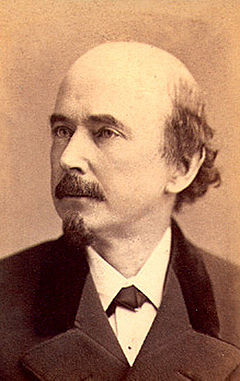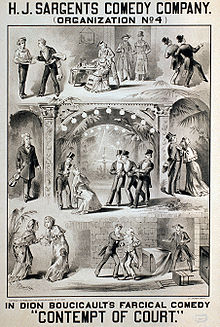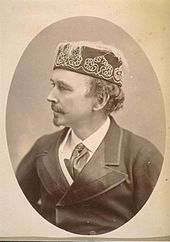- Dion Boucicault
-
This article is about Dion Boucicault Senior. For his actor and stage director son (1859-1929), see Dion Boucicault Jr..

Dion Boucicault, c. 1862Born Dionysius Lardner Boursiquot
December 26, 1820
Dublin, IrelandDied September 18, 1890 (aged 69)
New York City, New York, United StatesResting place Mount Hope Cemetery, Hastings-on-Hudson, New York, United States Occupation Playwright, actor Language English Nationality Irish Ethnicity Irish Alma mater University of London Notable work(s) London Assurance, The Octoroon, The Colleen Bawn, The Shaughraun Spouse(s) Anne Guiot (m.1845–d.1845)
Agnes Kelly Robertson (m.1853–d.1916; marriage dissolved 1888)
Josephine Louise Thorndyke (m.1885–1890; his death) (bigamously)Children Dion William Boucicault(1855–76)
Eva Boucicault (1857–1909)
Dionysius George Boucicault Jr. (1859–1929)
Patrice Boucicault (1862 – ?)
Nina Boucicault (1867–1950)
Aubrey Boucicault (1868–1913)Relative(s) Dionysius Lardner (putative father)
Anne Darley (mother)
George Darley (uncle)Dionysius Lardner Boursiquot (26 December c. 1820 – 18 September 1890), commonly known as Dion Boucicault, was an Irish actor and playwright famed for his melodramas. By the later part of the 19th century, Boucicault had become known on both sides of the Atlantic as one of the most successful actor-playwright-managers then in the English-speaking theatre. The New York Times heralded him in his obituary as "the most conspicuous English dramatist of the 19th century."[1]
Contents
Biography
Dionysius Lardner Boursiquot was born and educated in Dublin where he lived on Gardiner Street. His mother was Anne Darley, sister of the poet and mathematician George Darley, thus there was literary aptitude on his mother's side. The Darleys were an important Dublin family influential in many fields and related to the Guinnesses by marriage. The identity of his father is questionable. He was probably the son of Dionysius Lardner, a lodger at his mother's house at a time when she was recently separated from her husband,[2] and who supported him financially until about 1840.[3] He went to London and was enrolled at University College School at the age of 13 and also studied for a year at the University of London.
Work as actor and playwright
After a year in London, Boursiquot/Boucicault left to pursue acting in Cheltenham. He joined William Charles Macready while still young, and made his first appearance upon the stage with Benjamin Webster at Bristol, England. Soon afterwards he began to write plays, occasionally in conjunction.
His first play, A Legend of the Devil's Dyke, opened in Brighton in 1838. Three years later he found immediate success as a dramatist with London Assurance. Produced at Covent Garden on 4 March 1841, its cast included such well-known actors as Charles Mathews, William Farren, Mrs Nesbitt and Madame Vestris.
He rapidly followed this with a number of other plays, among the most successful of the early ones being The Bastile [sic], an "after-piece" (1842), Old Heads and Young Hearts (1844), The School for Scheming (1847), Confidence (1848) and The Knight Arva (1848, all at Her Majesty's Theatre),[4] as well as his very successful The Corsican Brothers (1852, for Charles Kean) and Louis XI (1855). The last two plays were adaptations of French plays.
In his play The Vampire (1852), Boucicault made his début as a leading actor as the vampire 'Sir Alan Raby'. Although the play itself had mixed reviews, Boucicault's characterization was praised as "a dreadful and weird thing played with immortal genius".[5] In 1854 he wrote and played the title character in Andy Blake; or, The Irish Diamond.[6]
From 1854 to 1860, Boucicault resided in the United States, where he was always a popular favorite. Boucicault and his actress wife, Agnes Robertson, toured America. He also wrote many successful plays there, acting in most of them. These included the popular Jessie Brown; or, The Relief of Lucknow in 1858.[6]
Work as theatre manager and producer
In the summer of 1859, Boucicault took over as manager of Burton's New Theatre (originally Tripler's Theatre) on Broadway just below Amity Street. After extensive remodeling, he renamed his new showplace the Winter Garden Theatre. There on 5 December 1859, he premiered his new sensation, the anti-slavery potboiler The Octoroon, in which he also starred. This was the first play to treat seriously of the Black American population. [3]
 Poster for a production of Boucicault's farce Contempt of Court, c. 1879. From the Library of Congress.
Poster for a production of Boucicault's farce Contempt of Court, c. 1879. From the Library of Congress.
On his return to England, he produced at the Adelphi Theatre a dramatic adaptation of Gerald Griffin's novel, The Collegians, entitled The Colleen Bawn. This play, one of the most successful of the times, was performed in almost every city of the United Kingdom and the United States. Although it made its author a handsome fortune, he lost it in the management of various London theatres.
After his return to England, Boucicault was asked by the noted American comedian Joseph Jefferson, who also starred in the production of Octoroon, to adapt Washington Irving's Rip van Winkle. He obliged and produced a version of the beloved American classic in 1866 that would make Jefferson one of the most famous and well-respected comedians of his age.
Boucicault's next marked success was at the Princess's Theatre, London in 1864 with Arrah-na-Pogue. He played the part of a County Wicklow, Ireland carman. This, and his admirable creation of "Conn"[7] in his play The Shaughraun (first produced at Wallacks Theatre, New York City, in 1874, then at the Theatre Royal, Drury Lane in 1875), won him the reputation of being the best "stage Irishman" of his time.
In 1875 Boucicault returned to New York City and finally made his home there. He wrote the melodrama Contempt of Court (poster, left) in 1879, but he paid occasional visits to London, where his last appearance was made in his play, The Jilt, in 1885. The Streets of London and After Dark were two of his late successes as a dramatist.
Boucicault was an excellent actor, especially in pathetic parts. His uncanny ability to play these low-status roles earned him the nickname "Little Man Dion" in theatrical circles. His plays are for the most part adaptations, but are often very ingenious in construction. They have had great popularity.
Family life
Boucicault was married three times. He married Anne Guiot at St Mary Lambeth on 9 July 1845, and he claimed that she died in a Swiss mountaineering accident later in the same year.[8][9] In 1853, he eloped with Agnes Kelly Robertson (1833–1916) to marry in New York. She was Charles Kean's ward; the juvenile lead in his company [10] and an actress of unusual ability. She would bear Dion six children: Dion William Boucicault (1855–1876); Eva Boucicault (1857–1909); Dion Jr. (1859–1929); Patrice Boucicault (1862–?); Nina Boucicault (1867–1950); Aubrey (1868–1913);[11] three of whom became distinguished actors in their own right. His granddaughter Rene Boucicault (1898–1935), Aubrey's daughter, became an actress and also acted in silent films.
Between 11 July and 8 October 1885, Boucicault toured Australia, where his brother Arthur lived.[12] Towards the end of this tour, he suddenly left Agnes to marry Josephine Louise Thorndyke (c. 1864–1956), a young actress, on 9 September 1885, in Sydney.[12] This aroused scandal on both sides of the Atlantic Ocean, as his marriage to Agnes was not finally dissolved until 21 June 1888, by reason of bigamy with adultery. The rights to many of his plays were later sold to finance alimony payments to his second wife.[13]
Boucicault died in 1890 in New York City, and was buried in Mount Hope Cemetery, Hastings-on-Hudson, New York.[14][15]
Selected works
- London Assurance (1841)
- The Bastile [sic] (1842)
- Old Heads and Young Hearts (1844)
- The School for Scheming (1847)
- Confidence (1848)
- The Knight Arva (1848)
- The Corsican Brothers (1852)
- The Vampire (1852)
- Louis XI (1855)
- The Poor of New York (1857)
- The Octoroon or Life in Louisiana (1859)
- The Colleen Bawn or The Brides of Garryowen (1860)
- Arrah-na-Pogue (1864)
- Rip van Winkle or The Sleep of Twenty Years (1866)
- After Dark: A Tale of London Life (1868)
- The Shaughraun (1874)
- The Jilt (1885)
Notes
- ^ "Dion Boucicault", The New York Times, September 19, 1890
- ^ 'The career of Dion Boucicault' Chapter 1, Walsh Townsend, 1915, ISBN 1432550705
- ^ a b Boylan, Henry (1998). A Dictionary of Irish Biography, 3rd Edition. Dublin: Gill and MacMillan. p. 31. ISBN 0-7171-2945-4.
- ^ Victoria Web accessed 1 June 2007
- ^ David J. Skal (2001) Vampires: Encounters With The Undead: 47-8
- ^ a b Stedman, Jane W. "General Utility: Victorian Author-Actors from Knowles to Pinero", Educational Theatre Journal, Vol. 24, No. 3, October 1972, pp. 289-301, Johns Hopkins University Press
- ^ Clapp, John Bouvé; Edgett, Edwin Francis (1902). "The Shaughraun". Plays of the Present. NY: The Dunlap Society. pp. 247–249. http://books.google.com/books?id=YhoOAAAAMAAJ&pg=PA247.
- ^ Anne Guiot Calthrop Boucicault Collection {University of Kent} accessed 5 January 2009
- ^ Anne Guilot was much older than Boucicault. The ADoB article on his son indicates the relationship was in existence by 1844, and she may have died as late as 1848.
- ^ Boucicault, Dionysius George (Dot) (1859–1929) (Australian Dictionary of Biography) accessed 5 January 2009
- ^ Aubrey Boucicault at the Internet Broadway Database accessed 6 January 2009
- ^ a b Josephine Louise Thorndyke Boucicault Calthrop Boucicault Collection {University of Kent} accessed 5 January 2009
- ^ Agnes Robertson Boucicault (1833-1916) Calthrop Boucicault Collection {University of Kent} accessed 5 January 2009
- ^ Letter from Josephine Cheney - formerly Boucicault (NY Times) accessed 5 January 2009.
- ^ Boucicault is buried in Section 43, Lot 1, near the top of the hill; his monument is a flat tablet of granite with a cast bronze marker giving his name and his life dates in Roman numerals.
See also
- Dionysius Lardner (probably Boucicault's natural father.)
References
- Asimov's Annotated Gilbert & Sullivan, Patience, note 31
- Michael Diamond, Victorian Sensation, (Anthem Press, 2003) ISBN 1-84331-150-X. Chapter 7.
- Richard Fawkes, Dion Boucicault (Quartet books, 1979)
- Anonymous (1873). Cartoon portraits and biographical sketches of men of the day. Illustrated by Waddy, Frederick. London: Tinsley Brothers. pp. 10–11. http://en.wikisource.org/wiki/Cartoon_portraits_and_biographical_sketches_of_men_of_the_day/Dion_Boucicault. Retrieved 2010-12-28.
External links
- Works by Dion Boucicault at Project Gutenberg
- A list of his works at www.scholars.nus.edu.sg
- The Fawkes Boucicault Collection at the University of Kent
- The Dion Boucicault Theatre Collection at the University of South Florida
- This article incorporates text from a publication now in the public domain: Cousin, John William (1910). A Short Biographical Dictionary of English Literature. London, J. M. Dent & Sons; New York, E. P. Dutton.
 This article incorporates text from a publication now in the public domain: Chisholm, Hugh, ed (1911). Encyclopædia Britannica (11th ed.). Cambridge University Press.
This article incorporates text from a publication now in the public domain: Chisholm, Hugh, ed (1911). Encyclopædia Britannica (11th ed.). Cambridge University Press.
Categories:- Irish stage actors
- Irish dramatists and playwrights
- People from County Dublin
- Old Gowers
- 1822 births
- 1890 deaths
- American dramatists and playwrights
Wikimedia Foundation. 2010.

